Once There Were Vikings
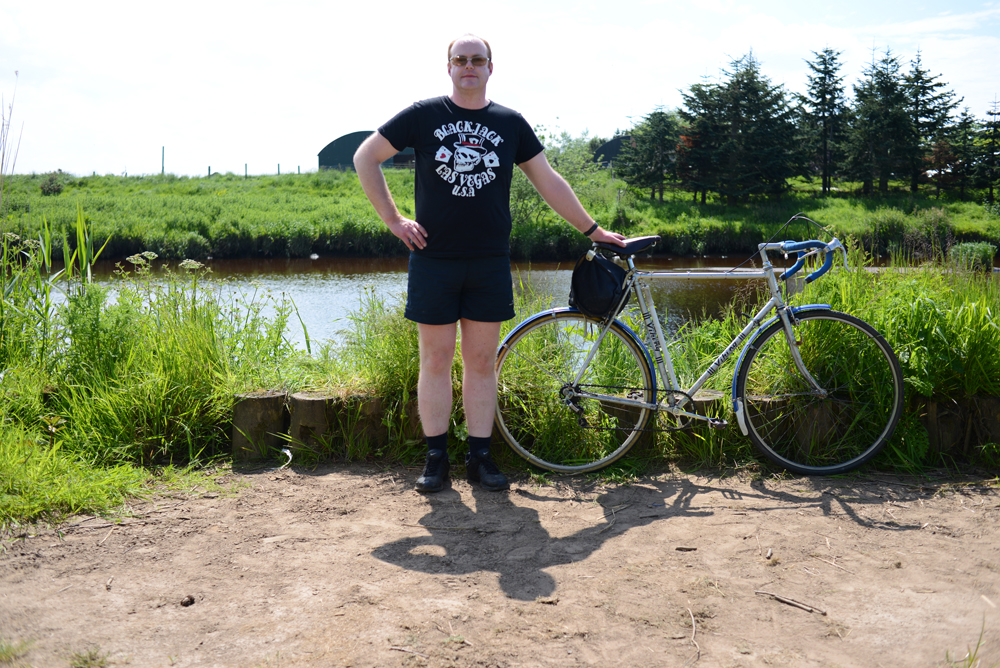
Over the weekend my pal Bryan visited from Donegal, and he brought along his current daily rider - a 1970s Viking. Chances are, you've never heard of the rather obscure Viking Cycles. But around here they are not uncommon, as they were once produced in Derry, Northern Ireland. This reminds me of a request I've had from bicycle enthusiasts with an interest in the Emerald Isle: to talk about Irish-made bikes. Were there any local manufacturers back in the day?
The short answer is that Ireland does not have a rich history of bicycle production. There was a handful of framebuilders active in Northern Ireland who made machines to order, and I've been gathering information about them with interest. But as far as manufacturers, large scale or small, my understanding is that there weren't any native to the island. At some point Raleigh opened a factory in Dublin, but they were a huge company with facilities all over the world. Viking Cycles, with their production exclusive to Derry from the 1970s until their demise, might be the closest thing to a local manufacturer.
Originally an English company, Viking was formed in 1908 (though this is debated) by Alfred Victor Davies in Wolverhampton. By the 1930s they were focused on "lightweights" and began sponsoring racing teams.
The beautifully lugged race bikes from this era were, by all accounts, of excellent quality, if not especially unique. "You're behind the times if you're not riding Viking!" the adverts from this period proclaimed.
This went on successfully until the 1960s, when Viking began to decline and eventually folded, its remnants sold to Lambert/Viscount (UK/USA), then Trusty (USA), then possibly to a man named Roy Clements. What happened during this period precisely is not known, but by 1977 Viking Cycles re-emerged as a new company, with production facilities in Northern Ireland.
Over the course of the year I've been here, I have seen perhaps a dozen NI Vikings, some as part of collections and others "in the wild." The description of these machines as "competent but uninspired bicycles" seems pretty much spot on. A couple of high-end, handbuilt models existed during this period as well, but examples of those show up very rarely.
The Vikings I've seen have been low to mid-range 10-speeds from the late '70s and '80s. The diamond frames and mixtes look well ridden, and by their owners' accounts were decent, no-frills bikes.
When exactly the Derry-based Viking folded is unclear, but production probably ended by the 1990s and officially the company was dissolved in 2012. Though the brand was hardly legendary, to local bicycle enthusiasts it is significant as a remnant of bicycle manufacturing in Northern Ireland.
The bicycle Bryan brought along is a Viking Superstar 5 -
- a basic lugged road bike with a single chainring 5-speed drivetrain
operated by a single downtube shifter.
This bike was rescued from the trash some years back, and Bryan nursed it back to health with some used replacement parts, including a Brooks Competition saddle, a rear wheel to replace the damaged original, and a set of 27 x 1 1/4" tires.
He replaced the original 46t chainring with a 40t to lower the gearing, and fitted some nice blue fenders. I thought these were Bluemel mudguards at first, but they are in fact a lower end alternative - made by a Scottish company called Bantel. The rich vibrant blue adds some lively accents to the all- silver bike.
In truth, to come up with much of interest about this machine other than its place of manufacture would be a struggle! But that's all right. It is a handsome bike, and a very ridable bike according to Bryan. He enjoys it as an everyday "user bike," as much as he enjoys knowing it was made just 20 miles from his house. Not many cyclists in Ireland can say that about their bicycle.
For more information about Viking, visit the V-CC-affiliated Classic Viking Cycles site, as well as this history page from the Transport Museum. Bryan's photos of his bicycles and other things can be found here. The other Viking frames shown in this post come from this collection.

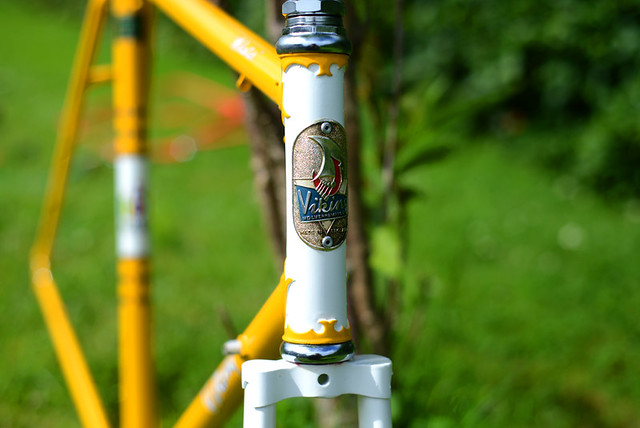
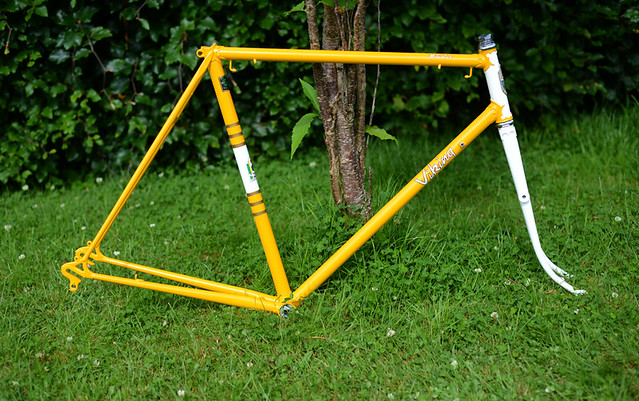
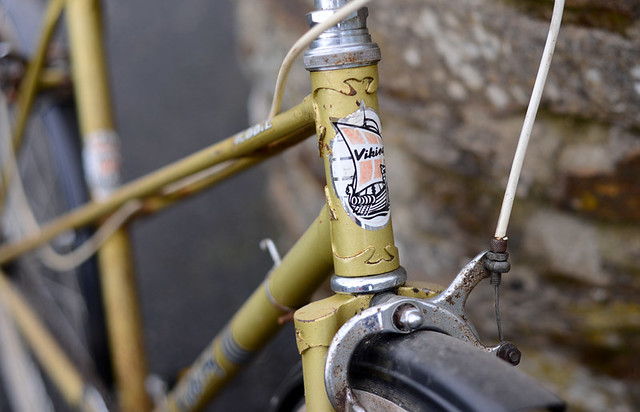

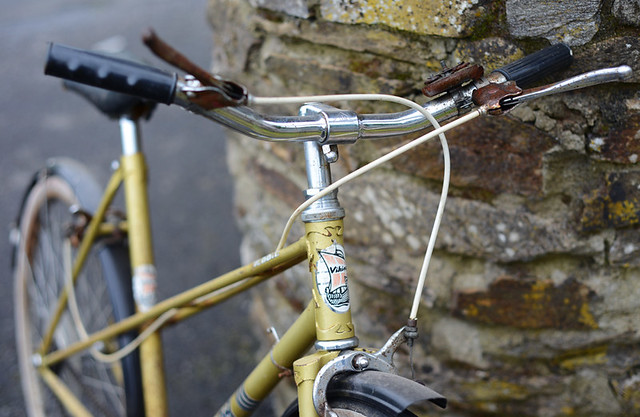
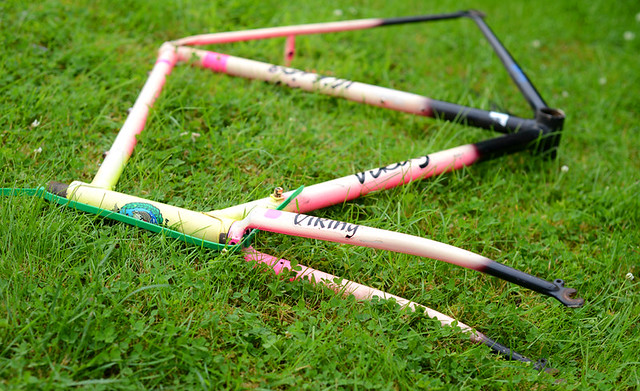


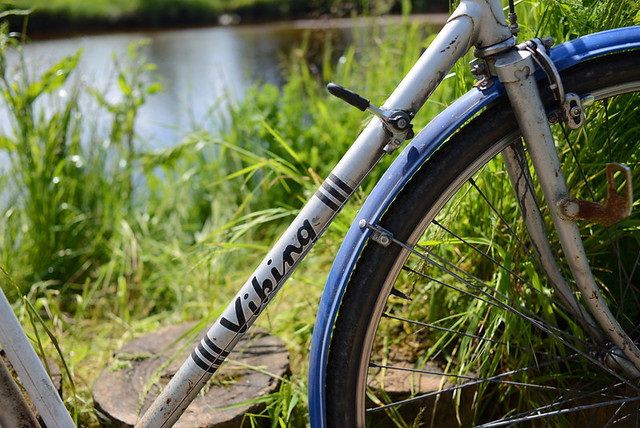
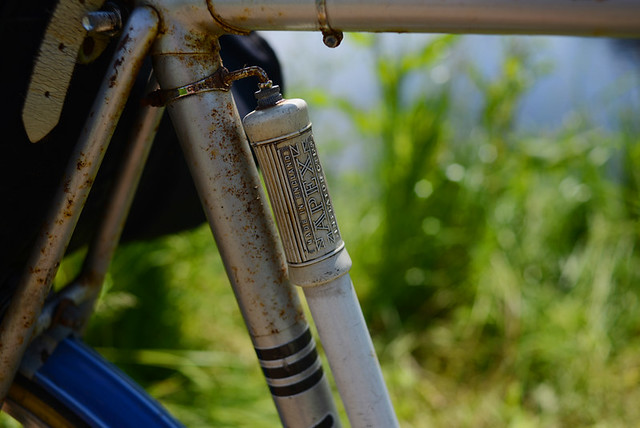
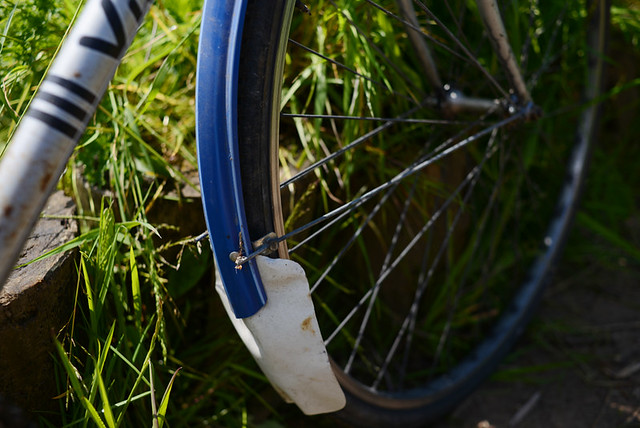
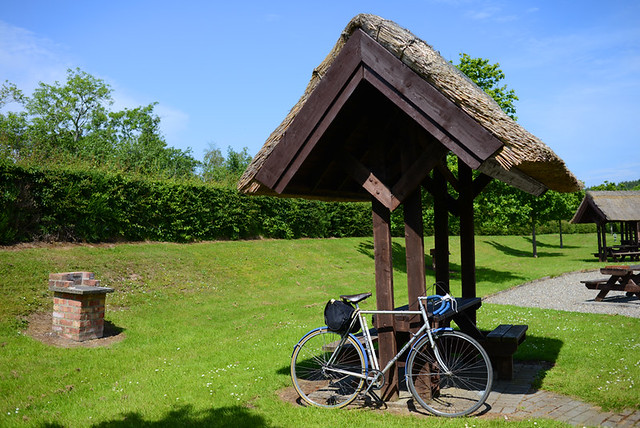
That Wolverhampton frame is nice. I like the paint scheme and the curve of the fork.
ReplyDeleteWas the single chainring common in UK and Ireland? I do not recall 70s era bikes available in the US setup this way.
ReplyDeleteI don't know about the 1970s, but when I toured Europe in 1967, most of the British cyclists I saw had a single front chainring and 5 gears in the back. I had three chainrings in front which caused the British cyclists endless amusement. "Hey, come here and look at the triple banger!" they would yell to each other.
DeleteMaybe it was. Certainly the 1970s bikes I've had here in the UK were all originally single chainring with 5-cog cassette... on bikes that otherwise remind me very much of the 10-speeds my brothers had in the 1970s in Oregon. I had no trouble sourcing a double chainring replacement for one of my UK-market Puchs, of exactly the same model/groupset as the original single chainring, so suspect both were readily available, just sold into different markets.
DeleteAnon 10:47
DeleteIn US market the most obvious would be Schwinn Collegiate and Raleigh Sprite. Plenty of others. The other obvious (if you were there and remember) fact is that while current single chainring drivetrains require layers of special purpose integrated finicky and quirky rigmarole all you had to do in the 70s was hang the parts on the bike and expect them to work.
"There was a handful of framebuilders active in Northern Ireland who made machines to order, and I've been gathering information about them with interest."
ReplyDeleteOh I look forward to that.
Also, does this mean you are only interested in builders from Northern Ireland, or were there none South of the Border?
The latter. Although just because I've not found any, doesn't mean none existed.
DeleteI own a Gordon made in Hillsborough, the bike workshop I used to work in has a Eddie Rafter (Belfast) and a 1950's stone special track made in Belfast. There are also Donaldson's an a few others. I think the Gordons are the pic of the bunch.
DeleteThis reminds me I have photos of a nice Gordon mixte that I keep meaning to upload.
DeleteSince the '80s, the only framebuilders I'm aware of in the Republic were Rapparee in Meath, named after an erstwhile highway man. They may still be on the go, but I'm not sure. They chiefly made racing frames, including many Softride beam bikes, but the odd touring frame escaped from time to time. Here's a racing example:
Deletehttp://thecyclingblog.com/2012/10/28/the-dream-machine/
The other was Di Zecca, made by a German in Bray, IIRC. His output also mainly consisted of racing frames, and I saw a fair number of beam bikes from him too. Irish roads, sure don't y'know?
British builders often produced bikes in Northern Ireland because labor costs were lower and, because NI was part of the UK, there were no tariffs.
ReplyDeleteI saw a few Vikings when I was in England. They are perfectly decent bikes but, as you said, not exceptional. It was rather ironic when they became Lambert/Viscount, as they were one of the few builders to make fillet-brazed (rather than lugged) frames.
This makes sense logically, but - and not to put you on the spot, but - which British builders? The ones I know of were all Raleigh sub-brands, and their production was in the Republic, not in NI.
DeleteBecause of the protectionist nature of the economy in the beginnings of the Irish Free State right through to the 1980s, most imported goods were hit with high import duties to protect local businesses, many large companies had assembly plants in ROI. Raleigh did this, as did Elswick and I'm sure other bike manufacturers. Having a factory in a nearby and "friendly" neutral territory also allowed Raleigh to supply the home market after the Nottingham factory was commandeered for military use.
DeleteIt extended far beyond bike manufacture as Ford, British Leyland, Fiat and Renault (and probably others) all had vehicle manufacturing plants. The Irish Post Office used Renault 4 vans as they were built in Waterford under agreement with Irish government. CIE had their own coachbuilding workshops to build buses on Leyland and Albion chassis. The list of things built in ROI is endless and mostly forgotten nowadays.
I am not aware of this having happened in NI to same extent. As part of the UK, there would have been no duties on goods imported from mainland Britain anyway and the NI market would have been very small.
The above was my understanding as well. According to the local collectors I know, there were no bike manufactures active in NI other than Viking and maybe a half dozen independent framebuilders.
DeleteWhen I first began working in bike shops during the 1970's, I saw some NI-maunfactured Raleighs. I also heard of Ulster-made Dawes, Elswick and other bikes with British marques.
DeleteThe explanation I gave in my earlier comment is one I heard from sales reps. I would also imagine that Raleigh might have turned to the NI because when the Bike Boom took hold in North America, the Heron as well as other makers struggled to keep up with the demand.
Belfast was a major manufacturing centre with ship building, aircraft and lots of other industry so it wouldn't be a surprise if this included bicycles but I can't say I've heard of any.
ReplyDeleteOne Irish link with bicycles is of course John Dunlop, inventor of the pneumatic tyre, although I think he sold out before the tyres went into mass production.
Today the Dunlop name is better known here in the context of motorcycle racing. At first I assumed it was the same family as the tyres Dunlop, but turns out there's no relation.
Deletehere's a gorgeous Viking shared via twitter
ReplyDeleteVery nice.
DeleteViking seemed familiar to me when I stumbled on them on the "Classic Lightweights" site but I don't know how I would have heard about them. I know I've ever seen one for reals. I wouldn't leave me alone in a room with yours without making me empty my pockets first, I so covet that headbadge.
Spindizzy
That is quite stunning.
DeleteThat is a beautiful bike.
DeleteI had a Viking as a kid in the late 70's. It was a Severn Valley and was old when I got it, scavenged off the tip, built up with other tip scavenged partsand the odd new purchase like a Huret Svelto rear mech. 5 speed single chainring "race" bikes were very common.
ReplyDeleteRight hand controls the front brake and left hand control the rear: it's a clue of British assembly.
ReplyDeleteI don't know if it's better or not.
L.
Better sensitivity for some right handers, like me.
DeleteLess chance of a brain fart going back and forth between motorcycles and bikes. After awhile, you don't think about it, it just happens.
It's not just British assembly L. Most vintage bicycles I rode in Austria were routed right=front, as well as Dutch bikes if I recall correctly. I set my own bikes that way as well.
DeleteThanks! I've been reading in bulk these links and I will read another one with both my two eyes in detail, I promise.
DeleteL.
Was Roy Clements any relation to Ernie; the British racer and later designer of Falcon bicycles?
ReplyDeleteYou may have your answer in comment posted below (Philip FosterJune 26, 2014 at 6:18 AM). :)
DeleteThe head badge on the yellow and white frame is in remarkable condition.
ReplyDeletegot I love bikes <3
ReplyDeleteI like the fact that your friend is riding that old bike around it's native landscape, it seems very correct that there should still be some of them working for a living in the area where they were made. Maybe the last one on it's wheels will be one that still lives around there.
ReplyDeleteIf the last Schwinn to roam the earth finally succumbs and collapses in the overgrown rubble that was Chicago, than all the misery and degradation of the last few chapters of Schwinn history will be redeemed( and a NEW CHROME wheeled savior of the AMURICAN BYSIKLE BIDNESS will arise and... well, that's probably too much to ask, but the old ones will likely outlast the Wal-Mart ones in any case...)!
Long Live Viking.
Spindizzy
An unspectacular but quality built bike can be your best friend. I never knew this brand existed. Thanks for bringing it to life
ReplyDeleteHello Veloria,
ReplyDeleteViking used to have a large showroom in Victoria street in Wolverhampton. They were the largest bicycle manufacturer in the town for about 40 years from the late twenties. The showroom closed I think sometime in the late 60s.
Wolverhampton had a number of bespoke builders at the time the most famous, Percy Stallard is the man credited with introducing Massed start road racing to England, at the RAF base at Cosford – 10 miles from Wolverhampton - in 1947.
Percy built beautiful bikes a business carried on by his son until the middle eighties.
Ron Clements, another bespoke builder owned a shop on the Dudley Road near the junction with the Birmingham New Road. I purchased my first proper road bike from Ron when I was thirteen in 1954, or rather my Dad did, classic 531 lugged frame in pale grey and red with Cyclo five speed gears and GB brakes.
Ron's cousin Ernie Clements also built very nice frames. At the time, the mid to late 1950's there were at least 15 bespoke builders in Black Country towns of Wolverhampton, Dudley, West Bromwich, and Walsall.
Philip in Narbonne
I have a Ron Clements Olympic ladies Lightweight Racing Bike. I bought it second-hand in 1959 from a lady in Wolverhampton. It must have been a few years old then but in excellent condition. Unfortunately being above 65 year old, it now has a little rust and the tires are rotten: it has lost its blue handlebar strapping and the drinking container etc. The Benelux gears work but in need of repair. I wonder if it's worth anything. Evelyn.
DeleteI've just come back to re-read this post and all the comments, as I've just pulled the trigger on a "Viking Bromley" singlespeed mixte. The main (if not exclusive) source in the UK appears to be Parkers of Bolton. Presumably they're made in Taiwan. I have been casting around (again) for a suitable bike for the London end of my commute, having been forced to give up on the 'swoopy' mixte. I wouldn't have considered one of these new Vikings except that a few weeks ago I spotted one locked to railings one street over from my office in the West End - and was pleasantly surprised at its build quality. Will do a full write up once I've got mine, but my first impression is that "competent but uninspired" may still be applicable.
ReplyDeleteWait, what is wrong with the swoopy mixte? I will visit the blog.
DeleteThe day after I published this post, I stumbled upon a lilac Viking Debutante 5-speed mixte in my size, so I now have that. It was obviously not intended to be a high end bike, yet the quality is impressive and it rides great too.
Ooooh, nice! I realise now I've seen it in recent posts but hadn't clocked it properly.
DeleteAs for Swoopy, I acquired the frame via Ebay and it turns out it's obviously been in a crash at some point in its history. The misalignment in the rear triangle is slight but significant enough that we just can't get the rear wheel axle to stay put. My BF is a life long bicycle tinkerer and recently qualified as a mechanic, working on all sorts and has been brilliant with all my various vintage projects. But he's not a framebuilder. Attempting to straighten the rear triangle by bending steel is beyond his comfort level. It's sad, but as has been said, the frame is not historically important so it's not the end of the world or anything like. ;)
Hi All. I am just getting around to restoring my 35 year old high end Viking. It has the old style tubeless tyres, the ones you stuck on with glue. Any advice on what I could replace them with; I want to retain the old wheels to keep it as authentic as possible. Also, I have some rust on the spokes; will some clear lacquer after some elbow grease with steel wool do the job. Many thanks.
ReplyDeleteLeo the Viking
One for sale Newcastle upon Tyne
ReplyDeletehttp://www.gumtree.com/p/bicycles/viking-european-1975-road-bike/1105921204
My Dad has a Viking Grand Tour in the garage, still in pretty decent condition for an old steel frame. According to him this one was custom made for a very tall rider and made in the Derry/Londonderry in Northern Ireland. One day I may consider trying to get it refurbed and get it out for a Sportive.
ReplyDeleteI had a Viking European I think in the 1970s. I bought it new, but at a knock down price, which was pretty good since it had Campagnolo gears, Mavic rims and very decent brakes. The saddle was awful, but easily replaced. All in all it was a lovely bike - a revelation to me, since I'd never ridden anything so light. I think it weighed in at 20 lbs and I could pick it up on my little finger. It had a Reynolds 531 frame, though not double butted. You had to get the considerably more expensive Severn Valley for that. I think a rider called Tony Doyle rode a Viking Severn Valley to beat the John o' Groats to Land's End
ReplyDeleterecord in the 1970s, so it must have been a very reputable bike.
My wife and I used to do quite a bit of holiday cycling in Norfolk and Suffolk in the 70s and 80s and I had a Mercian Touring bike made for me. My wife, who had always coveted the Viking took it over f rom me and loved it. And, guess what? I always liked it better than the much more expensive Mercian and borrowed it back whenever I could.